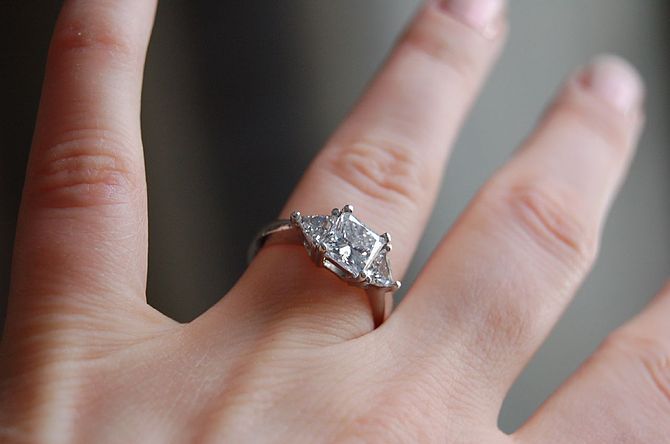How to Choose a Diamond Settings

First engagement ring – 1.51ct princess cut diamond (G/VS, GIA), 2 0.30ct trillions (G/VS), platinum setting. Sent it back – it wasn’t the right one. (Photo credit: Wikipedia)
The most popular type of setting for diamond jewelry is the prong setting. The setting holds the diamond strongly and prevents it from falling off. There are many varieties of diamond settings available that change the entire look of the diamond, making it more appealing.
The purpose of a setting is to enhance the impression and visibility of the diamond, while securing it sturdily. Few of the diamond settings are mentioned below:
Prong Settings:
Some common forms of prong settings are mentioned below, so choose according to your taste and preference:
Four-Prong Setting
If you want your diamond to look larger, choose a four-prong setting for your stone. Four-prongs are as strong as six-prongs, so opt for the one that visually appeals to you.
Six-Prong Setting
This is the most preferred choice among women. Besides being strong, six-prongs enhance the fire and brilliance of a diamond. Sadly, the chances of cloth and hair getting stuck into your ring are higher.
Cathedral Setting
This prong setting curves from the bottom of the diamond. If your diamond isn’t round or oval, opt for this setting to ensure the security of your precious stone.
Cross-Wire Lucida Prong Setting
If you are an athlete or a gym person, this prong setting is ideal for you. Cross-wire Lucida prong setting allows the diamond to assemble at the bottom without any chances of becoming loose.
Bezel Setting
If you want to hide any flaws present in your diamond, select this setting to hide any defects. Also, if your diamonds are small, Bezel setting makes them look bigger and brighter.
Channel Setting
If you have manifold diamonds and want them all to be studded in a single piece of jewelry, choose a channel setting. Channel setting enhances the whole look of the diamonds making them look stylish. This style suits both men and women.
Flush Setting
Small and flat diamonds can look attractive if studded into a flush setting. These diamond settings are ideally worn on a regular basis because they are not too showy.
A diamond setting matters to a great extent because they are one of the key determinants of a diamond’s look and appeal. It is worthwhile to decide upon your diamond jewelry setting before you purchase it for a special occasion.
